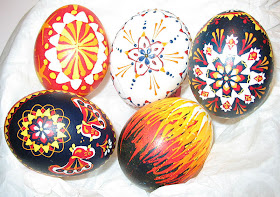Sorbia is a totally real place and not at all made up. It's a region of Germany and has a population of about 60,000. And what they do best is paint Easter eggs. There's a strong history of Easter egg painting in Eastern Europe and Germany, but Sorbia is famous for its egg-decorating tradition.
 |
| Photograph by Aineias |

I'm trying to think of a smart-arse pun based on the word "wend" but my efforts so far have been disappointing...
ReplyDeleteSorbs/Serbs - obviously not the same people (genetic research, unsurprisingly, relates the Sorbs most closely to the Czechs and Poles), but are the names cognates?
I wondered that myself and I found this quote on another website:
DeleteR.G.A. de Bray, in his "Guide to the Slavonic Languages" (J.M. Dent & Sons, 1951, rev. ed. 1969 which I do not have), begins his final chapter, "Lusatian (or Wendish)," as follows:
The Lusatians call themselves "Serbja" (Serbs) and their country "Luzhica" (Lusatia; in German—Lausitz). Hence the English name Lusatian Serbs. The Germans call them "Wenden" (slightly pejorative) or "Sorben"—hence the English use of "Wends" or "Sorbs". As the name "Serbs" can cause confusion with the Yugoslav Serbs of Serbia, while the term "Wend" or "Sorb" does not readily indicate a nationality to the English mind, we propose using the term "Lusatian" here. This name indicates the native land to which these Slavs are attached so passionately that they will not even hear of being transferred to other areas where there is a higher proportion of Slav inhabitants....
I think I may once have glanced at that book, oddly enough - it's probably that very section that is responsible for me knowing that Wends and Sorbs are the same thing. One of the maths teachers at my school had a copy of that or something very similar. It being a major public school, we had some brilliant but wierd teachers, and not one but two of the maths masters were polyglot polymaths. The one with the de Bray was a priest too.
DeleteThe other once presented our tutorial group with a Japanese newspaper and asked if we could work out what any of the symbols represented! I think he was fishing for us to guess that some of them were syllabic rather than ideogrammatic. We failed :)